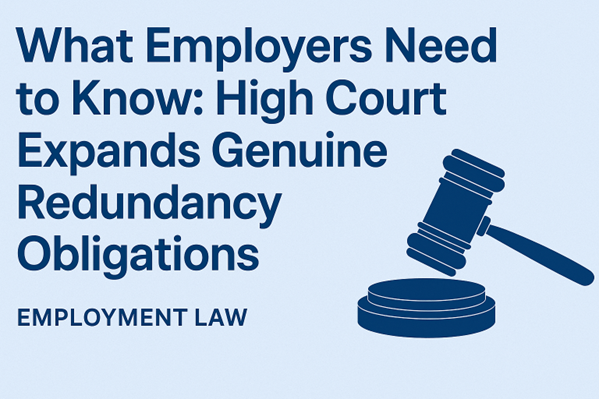In a landmark decision, the High Court of Australia has expanded employers’ genuine redundancy obligations, confirming that for a redundancy to be genuine, employers must explore all redeployment options, including the possibility of reallocating work performed by contractors to existing employees.
This decision serves as a critical reminder for businesses managing organisational change: genuine redundancy requires not just consultation, but a proactive review of how work can be reorganised to retain employees.
Background: What Happened at Helensburgh Coal
During the COVID-19 pandemic, reduced demand led Helensburgh Coal to scale back its operations, resulting in job losses. While the company consulted with employee representatives, workers urged the business to reduce its reliance on external contractors instead of making employees redundant.
Although Helensburgh reduced contractor use slightly, 90 employees were dismissed, and 47 were declared redundant. The affected workers argued that the company could have further reduced contractor work and redeployed existing employees.
After a series of Fair Work Commission (the Commission) hearings, it was determined that the dismissals were not genuine redundancies. Helensburgh appealed to the High Court, which unanimously upheld the Commission’s decision.
Legal Principles: What Is a Genuine Redundancy?
Under the Fair Work Act 2009 (Cth), a redundancy is genuine if:
- The employer no longer requires the job to be performed by anyone due to changes in operational requirements; and
- The employer has met all consultation obligations under an applicable award or enterprise agreement.
However, a redundancy is not genuine if it would have been reasonable to redeploy the employee within the organisation or an associated entity.
The High Court’s Decision
The High Court unanimously found that Helensburgh could have reasonably redeployed the affected workers into roles held by contractors. The Court confirmed that the Commission may examine whether an employer can restructure work to make redeployment possible, including bringing outsourced tasks back in-house.
This means that genuine redundancy extends beyond simply confirming that a role is no longer needed. Employers must consider whether the work itself can be reassigned to existing employees.
Access the High Court’s decision here.
Implications for Employers
This decision broadens the scope of what must be assessed before redundancies are made. Employers must now:
- Examine redeployment opportunities thoroughly even if this involves reconfiguring roles or reducing contractor use.
- Assess the employee’s skills and experience to determine if they can be trained or transitioned into alternative positions.
- Review workforce structures to identify if existing arrangements can be altered to preserve employment.
If an employer fails to make reasonable efforts to redeploy staff, the redundancy may be deemed non-genuine, exposing the business to unfair dismissal claims and potential reinstatement orders.
Key Takeaway
The High Court’s decision underscores that for an employer’s genuine redundancy obligations to be fulfilled, a redundancy must reflect a genuine operational change, not a convenient workforce adjustment. Employers must be able to demonstrate that they have considered all reasonable redeployment options, including those that involve modifying contractor arrangements or restructuring work.
Before finalising any redundancy process, employers should document all steps taken to explore redeployment and confirm that the role, not just the person, is no longer required.
For advice on how to approach redundancies or restructuring, or to discuss our full range of services, please contact our team at (02) 9181 5001 or by email at [email protected].

